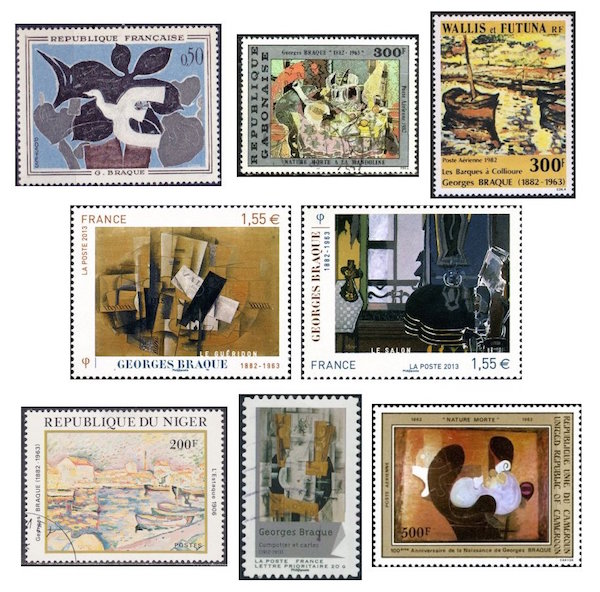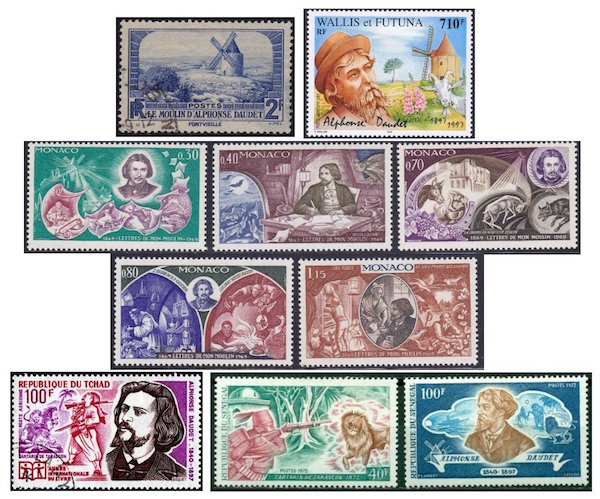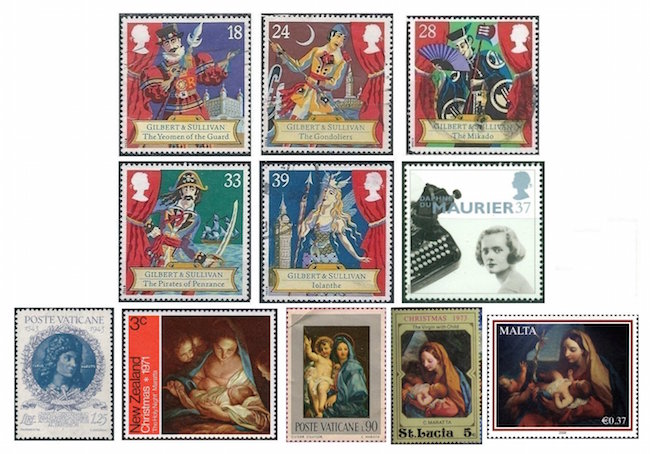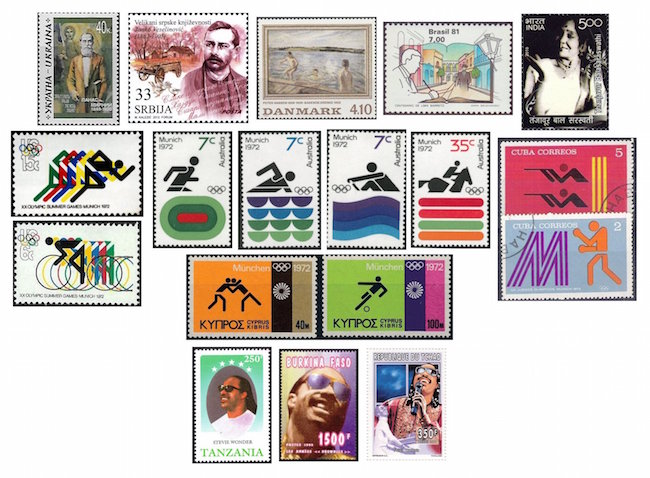The Arts on the Stamps of the World — May 13
An Arts Fuse regular feature: the arts on stamps of the world.

By Doug Briscoe
May 13 is the birthday of Georges Braque, Alphonse Daudet, Sir Arthur Sullivan, Daphne du Maurier, and Stevie Wonder, not to mention Italian painter Carlo Maratta and artists from Ukraine (playwright), Serbia (short story writer), Denmark (painter), Brazil (novelist), India (dancer), and Germany (graphic designer whose work I daresay you’ll recognize).
Born on 13 May 1882 in Argenteuil, Georges Braque might have followed in the footsteps of his father and grandfather as a house painter, but he also studied art at night. After an impressionist period he turned to the Fauves, but with friends Raoul Dufy and Othon Friesz sought to tone down the more “beastly” aspects of the style. Soon Braque was also influenced by the work of the recently (1906) deceased Cézanne, then considerations of perspective and geometry made themselves felt. He worked so closely with Picasso in these years that it was often difficult to tell one painter’s work from the other’s. Braque invented the papier collé technique at around this time. He volunteered to serve in the French Army when World War I broke out and was severely wounded in May 1915, experiencing temporary blindness and a lengthy recuperation time before he could resume painting. As he had done with Fauvism, he softened the more severe aspects of Cubism. We begin with a French stamp and a look at a work identified in the Scott stamp catalogue as The Messenger, but I can’t find this image (dissociated from the stamp) anywhere online. Next to that is Still life with mandolin (Nature morte à la mandore, 1909) on a stamp from Gabon. The Wallis and Futuna stamp of Les barques à Collioure, plays fast and loose with the original colors. In the second row, the French pair deals with pieces widely separated in time: Le Guéridon (The Table, 1911) and The Salon (1944). The earliest of the pieces on offer is L’Estaque (the name of a village near Marseilles, 1906) on a stamp from Niger. On another recent French stamp is Compotier et cartes (Fruit dish and cards, 1918), and lastly we see Grande nature morte brune (1932) on a Camerounian stamp.

Still in France, but back in the 19th century, we come to novelist Alphonse Daudet (13 May 1840 – 16 December 1897). He tried being a schoolteacher but couldn’t stand it, later reporting that he suffered from nightmares for months afterwards. Daudet later made lemonade from these lemons, however, working the material into his novel Le Petit Chose (1868, sometimes translated as Little Good-For-Nothing, but it seems to me The Little Something-or-Other might be a bit closer.) His first book, written he was while living with his brother Ernest, was a poetry collection called Les Amoureuses (1858), which did well. He started working for Le Figaro, added to his output with a few plays, and began to establish a respectable reputation. Lettres de mon moulin (Letters from My Windmill, 1866) is referenced not only on the old French stamp from 1936 (the issue celebrated the 70th anniversary of the book’s publication) and a bright example from Wallis and Futuna, but on an entire set of five stamps from Monaco. Six years later Daudet brought out his Aventures prodigieuses de Tartarin de Tarascon, reflected in the stamps from Chad and Senegal. 1872 also saw Daudet’s adaptation of his story L’Arlésienne into a three-act play, which was supplied with the now famous music by Bizet. Now for the bad news: Daudet was firmly if not fanatically antisemitic, a monarchist opponent of republicanism, repeatedly unfaithful to his wife, and died of syphilis.

Today is also the birthday of Sir Arthur Sullivan (1842 – 22 November 1900), the S part of G&S. In 1992, Great Britain commemorated the 150th anniversary of his birth with a set of stamps depicting characters from his and Gilbert’s most famous operettas. Besides his collaborations with W.S. Gilbert, Sullivan composed other works for the stage, including just one serious opera (on Sir Walter Scott’s Ivanhoe) and incidental music for several of Shakespeare’s plays, sacred and ceremonial choral works, an “Irish” Symphony, a Cello Concerto, and five concert overtures.
Another British stamp of similar vintage (1996) is the one for Daphne du Maurier (13 May 1907 – 19 April 1989), author of Rebecca (1938), Jamaica Inn (1936), and My Cousin Rachel (1951), all of which have been made into movies. A new version of My Cousin Rachel with, appropriately enough, Rachel Weisz, is set for release next month. Du Maurier’s eerie tales “The Birds” and “Don’t Look Now” were also made into fine films, the first, of course, by Hitchcock (1963), and the second, an effective retelling directed by Nicholas Roeg with Julie Christie and Donald Sutherland (in one of his early non-goofball roles) ten years later. A few more interesting factoids about Daphne du Maurier: she was the daughter of actor Gerald du Maurier, granddaughter of writer/artist George du Maurier, and cousin of the Llewelyn Davies boys, who inspired J. M. Barrie‘s Peter Pan. (We just saw stamps for this on Tuesday.) When the stage version of Rebecca opened in 1940, the role of Mrs. Danvers was played by an actress whose stamp we saw on Thursday, Margaret Rutherford. Du Maurier wrote two other plays and, later in life, non-fiction, including a biography of her father.
Let us repair to the 17th century.
The painter Carlo Maratta or Maratti (13 May 1625 – 15 December 1713) went from his native Camerano in the then Papal States to Rome in 1636 as an eleven-year-old apprentice to Andrea Sacchi, with whom he remained close until Sacchi’s death in 1661. After Bernini died in 1680, Maratta became the most prominent artist in Rome. In addition to the religious paintings we see today, he left a goodly number of portraits. After the Vatican stamp in his honor, we have a New Zealand Nativity for the 1971 Christmas season, then two madonnas, the second one appearing on two separate issues from St Lucia (1973) and Malta (1978). By the way, the MFA houses a Maratta Flagellation.

Panas Myrny (born Panas Yakovych Rudchenko, 13 May 1849 – 28 January 1920) was a Ukrainian playwright. From the age of fourteen he worked in the civil service, diverting himself of an evening with explorations into written fiction. In his youth he was associated with a revolutionary group and was endangered, but not arrested, when officials discovered forbidden publications during a search of his home. He founded his own publishing house in 1905, which pleaded for equal rights for women. By 1915 the Tsarist police were describing Myrny as a “politically suspicious person,” even though he had successfully hidden behind his pseudonym for years. Very little of his work saw publication in Russia, though it did appear abroad in such cities as Geneva. Myrny’s best known book, the sociopsychological novel Propashcha syla (Ruined Strength, 1880), was co-authored with his brother Ivan Rudchenko (aka Ivan Bilyk).
Another Slavic writer born on May 13th was the Serb Janko “Jan” Veselinović (1862 – 26 June 1905). He imbibed from his childhood observations of the violence of the Serbo-Turkish war (1876-8) a centuries-old militant Serbian tradition. His first work was a collection of stories, Pictures of Village Life (Slike iz soeskog života, 1866). Taking up his abode in Belgrade from 1893, he was first an associate editor of the Serbian News, then in 1894 founded his own journal, The Star. Veselinović also co-wrote plays for the Belgrade National Theater.
Now we move north for the Danish artist Peter Hansen (13 May 1868 – 6 October 1928), one of the “Funen Painters”, so named for the island where they lived and worked. Hansen was one of the first of this group to study with the influential Danish artist Kristian Zahrtmann. Hansen absorbed what he saw during his extensive travels to the Netherlands, Italy (including Pompei), Belgium, and Paris. The Van Gogh canvases he saw in 1893 were an influence, as was the light of Italy, as can be seen in his sun-drenched Badende drenge (Boys Bathing, 1902). His specialty was country scenes inspired by both Funen and Italy.
Only at this point in today’s piece do we leave Europe, first for Brazil, where Afonso Henriques de Lima Barreto was born on this date in 1881. He was a Pre-Modernist writer whose father’s close connections with a viscount helped Barreto get a good education. Unfortunately he was forced to cut that short to care for his brothers after their father’s mental incapacitation. Lima Barreto first achieved notoriety with his articles and with the founding of a well-received, albeit short-lived periodical called Floreal. His first novel came out shortly thereafter. Barreto rebelled against the formal, florid style of writing that had been the sine qua non of the serious literature of the day. His approach, of course, made his books more accessible to a wider reading public but earned him the contempt of the elite. His greatest work is the novel Triste Fim de Policarpo Quaresma (The Tragic Fate of Policarpo Quaresma, 1911), initially comic but turning more bitter in its satire as the story progresses. Late in life, Barreto himself suffered from severe depression, alcoholism, and treatments at various psychiatric hospitals and sanatoriums. He died on November 1, 1922.
Before we return to Europe (Germany), a quick side trip to India. Tanjore Balasaraswati (13 May 1918 – 9 February 1984) came from generations of Tamil musicians and dancers (devadasis). She was the first performer of her inherited style, called Bharatanatyam (or bharata natyam), to bring the tradition beyond South India (Calcutta, 1934). Indeed, she brought it well beyond local confines to a global audience and was admired by Margot Fonteyn, Martha Graham, and Merce Cunningham, among others. She founded a dance school in Madras and held residencies at a number of American universities as well as at Jacob’s Pillow. Her name is given as Tanjore on most online sources, but, as you can see, as Thanjavur on the stamp (also on the Encyclopedia Britannica’s website). I assume this is merely a matter of local variation.
German artist Otto “Otl” Aicher (13 May 1922 – 1 September 1991) was the graphic designer of the pictograms for the 1972 Summer Olympics in Munich, as can be seen on some of the stamp issues of the time, including the US designs. These stick figures (or their later incarnations) have come to be almost universally used for public signage. Aicher was also responsible for the typeface Rotis (1988) and for the revamped Lufthansa logo, based on an original design (by Otto Firle) of 1918. Aicher had, shall we say, an interesting early life. He was a friend of the Scholl family, in particular Werner Scholl, whose sister and brother Sophie and Hans would be executed in 1943 as members of the resistance movement the White Rose. (Werner went missing in action in 1944.) Aicher himself had been arrested in 1937 for refusing to join the Hitler Youth, and he deserted from the German army in 1945. After the war he studied sculpture in Munich. In 1952 he married Inge Scholl, the eldest of the Scholl siblings, with whom he co-founded the Ulm School of Design in 1953.

Our only subject today who is still living is Stevland Hardaway Morris (born Stevland Hardaway Judkins, May 13, 1950), but known to all as Stevie Wonder. He was born six weeks premature and suffered a condition called retinopathy of prematurity (ROP), in which the eyes do not develop properly, and the retinas become detached. With 25 Grammys (more than any other solo artist) and over 30 top ten hits to his credit, Stevie has been a pro since the age of 11, when he was signed up for a Motown label. His records have sold over 100 million copies, and he also won an Oscar for Best Original Song, “I Just Called to Say I Love You” from the 1984 movie The Woman in Red.
Happy birthday to American writer Armistead Maupin (born May 13, 1944)!
A graduate of the University of Massachusetts with a B.A. in English, Doug Briscoe worked in Boston classical music radio, at WCRB, WGBH, and WBUR, for about 25 years, beginning in 1977. He has the curious distinction of having succeeded Robert J. Lurtsema twice, first as host of WGBH’s weekday morning classical music program in 1993, then as host of the weekend program when Robert J.’s health failed in 2000. Doug also wrote liner notes for several of the late Gunther Schuller’s GM Recordings releases as well as program notes for the Boston Classical Orchestra. For the past few years he’s been posting a Facebook “blog” of classical music on stamps of the world, which has now been expanded to encompass all the arts for The Arts Fuse.

Fabulous stamps! Great info! Thank you every day of these posts.